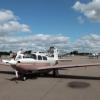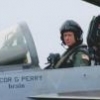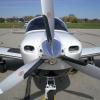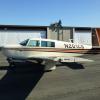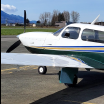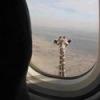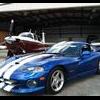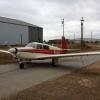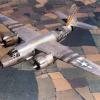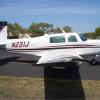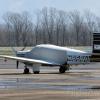Leaderboard
Popular Content
Showing content with the highest reputation on 10/31/2015 in all areas
-
Sorry, I never saw this! It was us on the way home from the US. We returned to Germany exactly one year ago, I attached a map with our whole journey depicted. For us it was the first atlantic crossing. However, the previous owner of N228RM, with whom we're still in good contact, did it at least ten times! Best regards, Gunter4 points
-
This morning I put the first flight on my new cowling. I'm pleased with what I've seen so far. The CHT's are better, the carb heat definitely works better than the original carb air box heat. The next few flights I'll get myself current and take some more data then go after performance numbers to see if I gained some speed. David3 points
-
Fellow Mooney Pilots, I wanted to post and let the community know about a great way to use your airplane - Volunteer Flying. I recently joined the Patient Airlift Services (PALS). I'd encourage all GA pilots to join this group or one similar like Angle Flight. http://www.palservices.org/2 points
-
Hum, that pretty much describes my 50 year old M20E. Including the owner's realistic expectations. If you want something for nothing, better stick to the obits and the bankruptcy filings.2 points
-
2 points
-
I've been involved with Northwood's Airlifeline (http://www.northwoodsairlifeline.org/) since 1991, and flying for them for over 20 years. It's hard to put into words the rewards you will receive from performing these kind of flights. If, over time, you don't get as much, or more, out of conducting the flight as the patient get's by you offering it, there's something wrong. I posted a tough flight a couple weeks ago, taking grandparents down to see their grand daughter just before passing. http://mooneyspace.com/topic/16721-tough-mercy-flight-yesterday/ I had one this Thursday night/Friday morning though that was rewarding. I flew a kidney transplant patient down to Madison WI for her transplant. http://flightaware.com/live/flight/N7256A/history/20151030/0400Z/KIMT/KMSN She had never flown, and when I asked her after landing how she did, she said "oh, I did just fine, I never opened my eyes the whole flight". Her daughter had flown, and loved the moonlit flight above the overcast. Ironically that afternoon and evening, I had a bank board meeting and we dined at a supper club afterwords. I was the only board member to not have any alcohol, and found out later when the call came in, was the only pilot available. Someone must have been looking over her, as she could not have made it in time without a flight. Tom2 points
-
Not necessarily. It's either 50 hours in the last 12 months OR several other options including a flight review. Here is the list: * Total PIC Time (250 hours for Private Pilot Certificate) * Cross Country PIC Time (75 hours) * Flight Review date within last 24 months * Total PIC time within last 12 months: 50 hours or: a Flight Review within the last 12 months; complete a Wings Pilot Proficiency Program Level; added a new Rating; or completed an IPC. Every Angel Flight organization is slightly different. I enjoy it. Weather permitting I try to do one long and one short flight each month. The 'long' flights are about 200-250 nm one way (my longest is 450 nm each way - long day). The short ones are usually under 100 nm and usually a run for the blood bank. By the time I include taxi time and positioning to or from the correct airport, that usually gets me something between 4 and 5 hours each month. That pretty much gets me to the 50 hours/year. Add in a flight each month for instrument currency and 50 hours isn't much of a problem. Like I've said before, it gives you an excuse to go flying, it lets you help someone in need, and it's a tax deduction. If you get the Philips 66 credit card and buy their gas for the mission, save an extra $1/gallon. Win, win, win, win. As for me, I've found that few things in life make me feel as good as helping someone in need.2 points
-
2 points
-
You're absolutely right George. I also volunteer using my Mooney as an Angel Flight NE pilot. It's a very rewarding way to give back to our fellow human beings who need and appreciate our services. I am grateful to them for allowing me the opportunity to do my small part enabling them to get the medical care they need. The smiles on their faces, especially when it's a younger patient, is all I need!2 points
-
Loading up this am in CYYR, I see a lovely little K taxiing out, bound for Greenland. Anyone we know? Sent from my iPhone using Tapatalk1 point
-
1 point
-
Bob... I told Mrs Belville I've got dibs on that E when you kick the bucket! Or if you decide to sell earlier, I'm on my way with a suitcase full of $100's.1 point
-
Yeah, he bought it at an estate sale. The original owner died suddenly after his wife found out how much he had spent on his ratty old Mooney. Personally, if I were in the market for an older Mooney, my "must haves" would be (In no particular order): 1965 to 1967 M20E - I want fuel injection and I believe that those years were of a bit better build quality. Solid maintenance history - I'm not interested in a project airplane or having to play a bunch of "catch up ball" when it comes to maintenance. Low time since a "quality" major or factory remanufactured engine. Very good to excellent cosmetics - paint, interior, and glass. Updated panel and avionics. Typical airframe mods - windshield, cowl, gap seals, etc. Corrosion-free airframe. To take an older "beater" airframe and try to bring it up to snuff is virtually guaranteed to be a loser financially. Even if someone gave you the airframe, you'd still end up spending way more that it would ever be worth. The only way it would make financial sense is if you find one with all (or at least most) of the good stuff already on the used market and let the seller take the financial hit. The problem with this is that many sellers have unrealistic expectations of what their "baby" is worth.1 point
-
Flew to GED today. I got an app in my iphone called Slow Shutter to experiment and see if it'll help eliminate prop shadow in pictures. Didn't work 100% but helped a little. I still need to play with the settings. Has anyone used it or another app maybe to eliminate prop? Is it even possible to do this through an app? Anyway, it was a beautiful flight. Fall is definitely in the air!1 point
-
1 point
-
Well I did the prop a few weeks ago. I think the other two look worse. The prop goes through the firewall high up and very accessible compared to the other 2. This morning I was in Jackson TN. Temps got into the high 30s and the plane was parked on the ramp. The mixture cable was so stiff I could not cycle it until I took off the side cowl and got it warmed up. All 3 cables seem to have been installed 18 years ago and are ACS. Going back with McFarlane. Sure wish I'd thought to replace them when I had the engine off!1 point
-
1 point
-
Shop around for the installer. These are not rocket since to install. The wiring harness is mostly complete, well labeled and only requires crimping the sensor end terminals. The install manual does a good job of covering each sensor and it's mostly a process of connecting red wire to red wire and yellow to yellow. It don't require an avionics shop if you have an IA who I will take the time to refer to the manual. I did both my 830 and 900 under my IA's supervision and everything worked correctly. I know a few others who have done th same.1 point
-
its far from perfect in Europe (although I rarely get one as long as the Mooney is running), but long haul has for a long time since moved from "Trolly Dollies" to "Wagon Dragons"1 point
-
Must have been a mis-type. Some 201 windshields remove or change the access panels that are nice to have. The only reason to remove the windshield is to change it for a new one. Congrats Barcho. Great acquisition. Best regards, -a-1 point
-
NICE panel! You need to introduce us to the owner who did that. He is a member of "Are you crazy for spending that kind of money on a 50 year old airplane" club. Just don't tell us you bought it at an estate sale! Sent from my iPad using Tapatalk1 point
-
From Saturday 10/24/2015. Two short clips. Sorry, no music, no editing, amateur video, Using the Mooney as intended. Too go visit Dad more often and more quickly. Youngest son Will (just turned 10), enjoying accompanying me. He slept for almost an hour on the way back. Thanks for viewing, Lance1 point
-
Steve, I was in your same position 2 years ago. I am a low lander (Lubbock, TX) and frequently fly west into Colorado, Wyoming and Montana. I desperately wanted a 252 withTKS but the $150,000 price tag AND my low time as a pilot steered me away. I purchased a '81 231 with a high time engine (1400 SMOH) at a good price because of the fear that 10 seconds of mishandling the engine would make it explode. The overhaul was built into my budget for the next couple of years and it will definitely be more than a Lycoming 360. I have 200 hours in the plane and couldn't be happier. I have two annuals behind me and the 231 is slightly more to maintain but not as bad as many people try to scare with. It is also more forgiving than you may think. I will not explode if you take off at 38.1" of MP and I think it is easier to land than a J maybe because of the heavier nose. I would echo some of the others that if getting high to avoid rocks and getting there quickly is important, then a 231 would be a good plane for you. I routinely take off 100 under gross in the summer mornings with DA around 8500 and do not have to circle to clear the mountains around the airport. As far as TKS, it was on my original wish list but I'm not sure that it wouldn't have led me to push into a bad situation. If I am flying on a tight schedule especially in winter, I book a refundable airline ticket. I have had to use that ticket twice and it sucked but I was alive to explain it to my wife. Finally, the oxygen thing. If you hate flying that high, then a 231 is kinda a waste. I often fly east at 13,500 for better winds and jewels is only marginally faster than a J. Flying west at 20,000 I have seen GS over 220. Either way, they are great planes. Don't get pushed away from a 231 IF it meets your needs.1 point
-
I don't know anything about this plane other than what's in the advertisement, but I would probably consider it over any 231. A little negotiation on price could get you where you need to be. With the understanding that the engine is getting to be higher time and that could potentially cost you more. http://www.controller.com/listingsdetail/aircraft-for-sale/MOONEY-M20K-252TSE/1986-MOONEY-M20K-252TSE/1360227.htm1 point
-
1 point
-
Friday- Flew from Arkansas to Charleston. Had a 5:45 am CDT departure and climbed to my cruising altitude of 13,000 between layers. Got to try out my new Oxygen system I bought at Oshkosh this year. Landed at Gadsen Alabama for fuel before going through ATL Center airspace as I have had them vector me all over in the past. Had full service fueling done while I was standing there. Took 24.6 gallons but the line guy tried to charge me for 26.7 gallons. He chuckled that he must be dyslexic (he didn't even have the right numbers to support dyslexia). This is why I always witness the fueling process after I was overcharged in Youngstown Ohio last year (equated to a 13.5 GPH fuel burn in a C model!) Departed Gadsen and shortly after handoff to ATL Center...the re routing game started. Look at my Flightaware to see the path they took me on. Made it into Charleston without any issues and was surprised at the lack of traffic. I was cleared to land as #1. After completing my business, I flew to Morehead City, NC to spend the night with friends. Arrived MRH shortly after 5:00 pm EDT. Left MRH Saturday morning, refueled (self fueling) at GAD and arrived back home in time to pull my cowling and do an oil change. I have the best wife as she met me at the airport with dinner in hand that enabled me to tackle the oil change. Needless to say I was a little tired on Sunday.1 point
-
I have a 66 E model that had a bad friction prob and i will explain you how i changed it from a poor to perfect system: 1. Pull off belly pan and check metal chain that connects trim wheel to sprocket. The chain must have about 3/16" of flex and be well lubed. If too loose the chain will fold and jam. If too tight it causes a lot of friction. Adjust chain length with the 2 adj. bolts/nuts in the cabin on the trim wheel base. If trim wheel unit not sat. Remove trim tube to rear jack screw and try to turn trim tube by hand. Turns easily if tail jack screw is ok. Trim box should also turn easily. Fyi, original grease in trim box will be hard as a rock and gears will be dry and perhaps worn.. Remove box, disassemble, clean and reassemble with moly fortified grease. 2. Proceed to rear jack screw. Inspect threads for wear, if acceptable grease with a moly fortified Aircraft grease. Remove co pilot access cover and hand turn trim control tube. Have a co conspiritor put positive and negative pressure on tail assy. You will probably find the bearings inside the jack screw "box"(which holds the jack screw) bind up under pressure. Remove jack screw assy. By removing the 2 long retaining bolts and detach jack screw from tail assy. There are 2 sealed bearings inside which have been dry for many years and are worn and flat sided. They must be replaced. The bearings are mounted on a bronze carrier shaft with an integral spacer between the 2 bearings. This requires each bearing to be pulled away from the spacer for removal.. Approved bearings can be purchased for $40 ea. on Web or $80 from AC dealer. You will not believe how easily the trim system now works..1 point
-
Do you mean a normal "week" which is generally considered to be 7 days, or an aviation "week" that can vary from 14 days to 6 months.1 point


